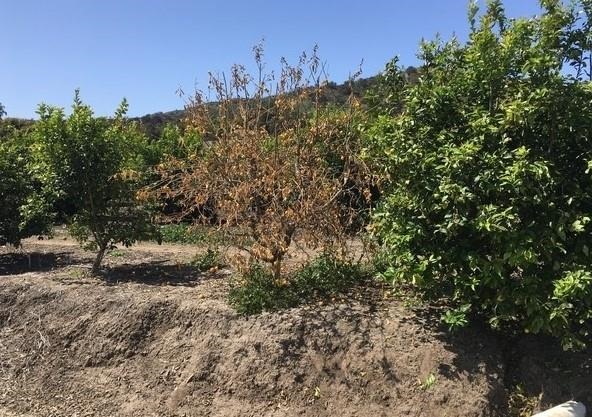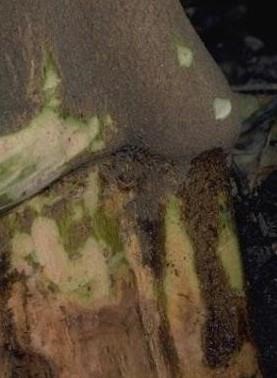By Ben Faber
The calls have come in. Citrus Dry Root Rot has struck. It's not supposed to happen this time of year. We've gone from this beautiful, rainy December to a mild winter mid-80s on some days. But, we had a fierce Santa Ana mid-January that knocked down street trees and caused other damage. And that's the cause. The devil wind. It's shocking how fast the citrus trees go from green to a lifeless brown.

BOOM!
The parting words of my predecessor Nick Sakovich (happily living in Hawaii) were: DRR hits trees between 1-15 years of age, less-well managed trees, trees that have been injured (gophers, weed whips, discing, fertilizer burn, etc.), in the presence of the Fusarium fungus, and it always happens on the first hot day of spring. A nice mild, or even cool winter, and then there is a sudden water demand by the tree on a hot day and BOOM, the tree's leaves turn brown in a weekend.
Dry Root Rot has menaced growers in Ventura County for many years. In the ‘50's and ‘60's it seemed most prevalent on older orange trees. A few years after the wet winter of 1968-69, dry root rot became an increasing problem among citrus trees of all ages. At that time, most of the damaged trees were on sweet rootstock (susceptible to Phytophthora), and growing in fine-textured soils or soils with poor drainage. A few years after another wet winter/spring (of 1983), dry root rot again reared its ugly head, but this time predominately on young lemons.
The disease is caused by the fungus, Fusarium solani. Fusarium in citrus clogs the xylem which carries water to the leaves. When damage is done to the xylem, the ability to carry water is reduced. When a lot of damage is done, that's when you get that BOOM.

The damage occurs at the base of the trunk. The bark has been cut away to show the affected wood beneath
This fungus is most likely present in all citrus soils in California. It is a weak pathogen in that by itself it will not attack a healthy tree. However, experiments conducted in the early 1980's by Dr. Gary Bender, showed that when seedlings were girdled, root invasion occurred. In the field, the fungus can infect trees once gophers have girdled the roots or crown. A Phytophthora infection will also predispose trees to Fusarium, as will asphyxiation. Therefore, the mere presence of the fungus in the orchard soil will not lead to the disease.
So we call it a disease, but it's really a complex of circumstances that need to be present. It has to be a wound, Fusarium and the weather. We forget that wind is a greater drain on a tree's water needs than heat is actually. Same for humans, you got out on a windy day, and you come home and the first thing you do is drink some water. That's the way food is freeze-dried.
And that's the stress we had this year, and BOOM!
There's not a whole lot that can be done after this happens. The way it is managed is through avoiding wounds and making sure that when stressful conditions of wind and heat are forecast, that the tree is well supplied with water.
Nick was mainly right. Dry Root Rot mainly happens with the first hot day of spring, but it can happen anytime a wounded, infected tree goes under water stress. And it can happen to older trees, too.
Source : ucanr.edu